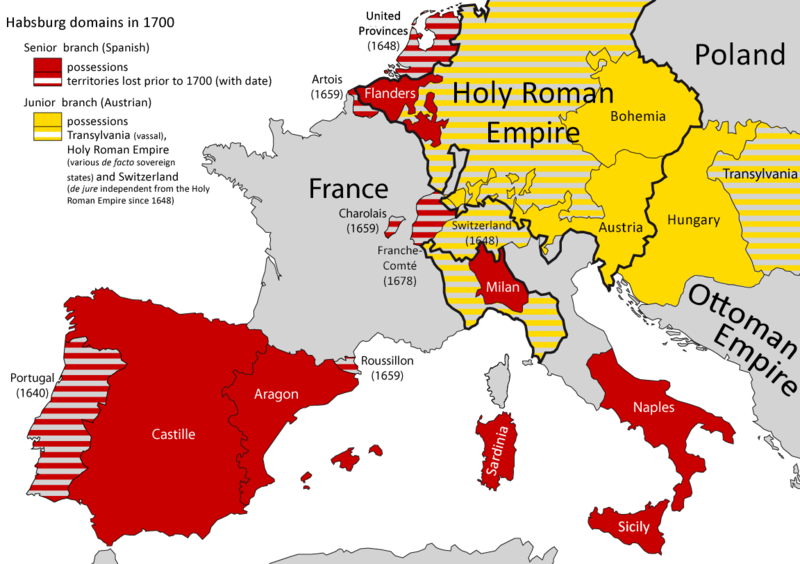
Spanish and Austrian Habsburgs
fter the assignment, on 21 April 1521, of the Austrian lands to Ferdinand I by his brother Emperor Charles V (also King Charles I of Spain) (1516–1556), the dynasty split into the junior branch of the Austrian Habsburgs and the senior branch of the Spanish Habsburgs. The Austrian Habsburgs held the title of Holy Roman Emperor after Charles' death in 1558, as well as the Habsburg Hereditary Lands and the Kingdoms of Bohemia and Hungary.
The senior Spanish branch ruled over Spain, its Italian possessions and its colonial empire, the Netherlands, and, for a time (1580–1640), Portugal. Hungary was partly under Habsburg rule from 1526. For 150 years most of the country was occupied by the Ottoman Turks but these territories were re-conquered in 1683–1699.
In the secret Oñate treaty, the Spanish and Austrian Habsburgs settled their mutual claims. The Spanish Habsburgs died out in 1700 (prompting the War of the Spanish Succession), as did the last male of the Austrian Habsburg line in 1740 (prompting the War of the Austrian Succession), and finally the last female of the Habsburg male line in 1780
Extinction of the Spanish Habsburgs[edit]
The Habsburgs sought to consolidate their power by the frequent use of consanguineous marriages. They were said to have a proverb that 'The best spouse for a Habsburg is another Habsburg.'[citation needed] This resulted in a cumulatively deleterious effect on their gene pool. Marriages between first cousins, or between uncle and niece, were commonplace in the family. A study of 3,000 family members over 16 generations by the University of Santiago de Compostela suggests that inbreeding directly led to their extinction. The gene pool eventually became so small that the last of the Spanish lineCharles II, who was severely disabled from birth, perhaps by genetic disorders, possessed a genome comparable to that of a child born to a brother and sister, as did his father, probably because of "remote inbreeding".[11][12]

Extinction of the Austrian Habsburgs[edit]
The Austrian branch became extinct in the male line in 1740 with the death of Charles VI and in the female line in 1780 with the death of his daughter Maria Theresa; it was succeeded by the Vaudemont branch of the House of Lorraine in the person of her son Joseph II. The new successor house styled itself formally as House of Habsburg-Lorraine(German: Habsburg-Lothringen), although it was often referred to as simply the House of Habsburg. The heiress of the last Austrian Habsburgs Maria Theresa had marriedFrancis Stephan, Duke of Lorraine[13] (both of them were great-grandchildren of Habsburg Emperor Ferdinand III, but from different empresses). Their descendants carried on the Habsburg tradition from Vienna under the dynastic name Habsburg-Lorraine, although technically a new ruling house came into existence in the Austrian territories, the House of Lorraine (see Dukes of Lorraine family tree). It is thought that extensive intra-family marriages within both lines contributed to their extinctions
Habsburg-Lorraine
On 6 August 1806 the Holy Roman Empire was dissolved under the French Emperor Napoleon I's reorganization of Germany. However, in anticipation of the loss of his title of Holy Roman Emperor, Francis II declared himself hereditaryEmperor of Austria (as Francis I) on 11 August 1804, three months after Napoleon had declared himself Emperor of the French on 18 May 1804.
Emperor Francis I of Austria used the official full list of titles: "We, Francis the First, by the grace of God Emperor of Austria; King of Jerusalem, Hungary, Bohemia, Dalmatia, Croatia, Slavonia, Galicia and Lodomeria; Archduke of Austria; Duke of Lorraine, Salzburg, Würzburg, Franconia, Styria, Carinthia, and Carniola; Grand Duke of Cracow; Grand Prince of Transylvania; Margrave of Moravia; Duke of Sandomir, Masovia, Lublin, Upper and Lower Silesia, Auschwitz andZator, Teschen, and Friule; Prince of Berchtesgaden and Mergentheim; Princely Count of Habsburg, Gorizia, andGradisca and of the Tyrol; and Margrave of Upper and Lower Lusatia and Istria".
The Austro-Hungarian Compromise of 1867 created a real union, whereby the Kingdom of Hungary was granted co-equality with the Empire of Austria, that henceforth didn't include the Kingdom of Hungary as a crownland anymore. The Austrian and the Hungarian lands became independent entities enjoying equal status[15] Under this arrangement, the Hungarians referred to their ruler as king and never emperor (see k. u. k.). This prevailed until the Habsburgs' deposition from both Austria and Hungary in 1918 following defeat in World War I.
On 11 November 1918, with his empire collapsing around him, the last Habsburg ruler, Charles I (who also reigned as Charles IV of Hungary) issued a proclamation recognizing Austria's right to determine the future of the state and renouncing any role in state affairs. Two days later, he issued a separate proclamation for Hungary. Even though he did not officially abdicate, this is considered the end of the Habsburg dynasty. In 1919, the new republican Austrian government subsequently passed a law banishing the Habsburgs from Austrian territory until they renounced all intentions of regaining the throne and accepted the status of private citizens. Charles made several attempts to regain the throne of Hungary, and in 1921 the Hungarian government passed a law which revoked Charles' rights and dethroned the Habsburgs.
The Habsburgs did not formally abandon all hope of returning to power until Otto von Habsburg, Emperor Charles' eldest son, renounced all claims to the throne.
The dynasty's motto, "Leave the waging of wars to others! But you, happy Austria, marry; for the realms which Mars awards to others, Venus transfers to you.",[16] indicates the knack of the Habsburgs to have members intermarry into other royal houses in order to build alliances and inherit territory. Empress Maria Theresa is recognized quite notably for it and is sometimes referred to as the "Great-Grandmother of Europe"
No comments:
Post a Comment